Center News & Funding, Research
Dec 12, 2023
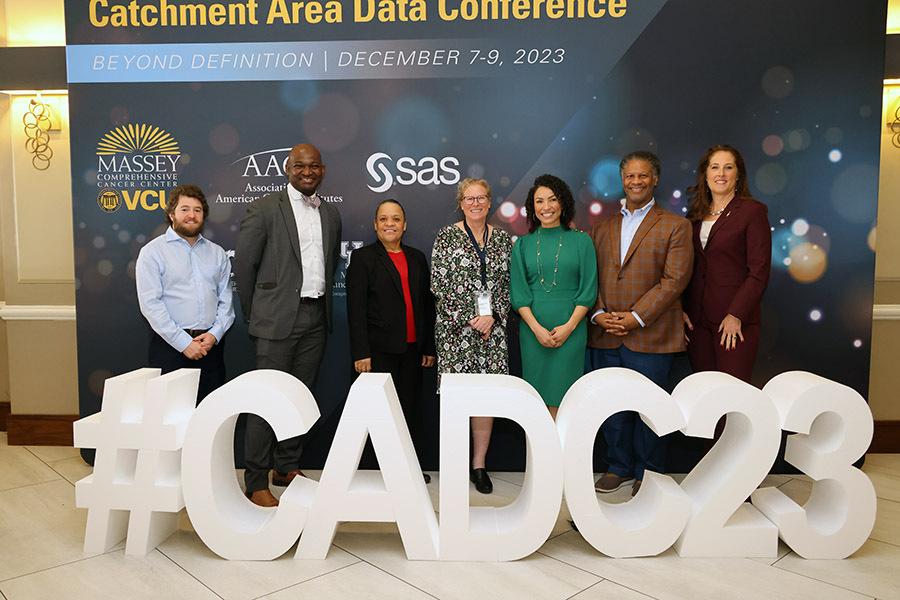 VCU Massey Comprehensive Cancer Center hosted the inaugural Catchment Area Data Conference (CADC) – Beyond Definition at the Richmond Marriott on Dec. 7-9. Pictured from left to right: Chris McNair, Ph.D., Karriem Watson, M.S., M.P.H., Lisa Richardson, M.D., M.P.H., Recinda Sherman, Ph.D., M.P.H., Katherine Tossas, Ph.D., M.S., Robert A. Winn, M.D., and Karen Knudsen, Ph.D., M.B.A.
VCU Massey Comprehensive Cancer Center hosted the inaugural Catchment Area Data Conference (CADC) – Beyond Definition at the Richmond Marriott on Dec. 7-9. Pictured from left to right: Chris McNair, Ph.D., Karriem Watson, M.S., M.P.H., Lisa Richardson, M.D., M.P.H., Recinda Sherman, Ph.D., M.P.H., Katherine Tossas, Ph.D., M.S., Robert A. Winn, M.D., and Karen Knudsen, Ph.D., M.B.A.
VCU Massey Comprehensive Cancer Center hosted the inaugural Catchment Area Data Conference (CADC) – Beyond Definition at the Richmond Marriott on Dec. 7-9. This first-of-its-kind national conference served as a transformative event for catchment area data analytics, bringing together the brightest and most passionate scientific minds to discuss and share best practices in cancer health data collection, handling, dissemination and utilization, while also exploring policies and methodologies to advance cancer center catchment area analytics.
“Catchment area data is an interesting term because most people don't know what it is or what it means,” said Robert A. Winn, M.D., director of Massey, senior associate dean for cancer innovation at the VCU School of Medicine and the president of the Association of American Cancer Institutes (AACI). “It turns out that once we started defining a catchment area — where our patients came from — we were able to then start targeting within that catchment, getting better data that informed our outreach and engagement efforts a little bit better and actually allowed us as a cancer center to better serve.”
The conference — which welcomed nearly 300 attendees from 37 states and Puerto Rico, with representation from 65 different cancer centers — included engaging presentations and discussions with more than 40 esteemed speakers from renowned national, state and local organizations, including the National Institutes of Health (NIH), the National Cancer Institute (NCI), the Centers for Disease Control and Prevention (CDC), the Agency for Healthcare Research and Quality (AHRQ), American Cancer Society (ACS), AACI, and Association of Community Cancer Center (ACCC) members, among others.
The CADC is the brainchild of Katherine Tossas, Ph.D., M.S., director of catchment area data access and alignment at Massey and an assistant professor and Harrison Endowed Scholar in the Department of Health Behavior and Policy at the VCU School of Medicine.
“We are now at the stage where we are responsible for demonstrating our impact on the catchment area,” Tossas said. “This conference is intended to bring all of these different voices together to brainstorm: How do we collectively increase the impact on the catchment? What should we be looking at that we're not currently looking at? How should we ask the questions? Who should be at the table? Where is the community in all of this? Who are the ones that are impacted by it?”
“This conference had to happen because it’s almost as if we had outreach and engagement as one arm and catchment area data as the other arm, but the two never actually built a bridge across the table to share the data in a way that could help both,” Winn said. “We hope this conference sets the foundation for future meetings in which we really are serious about how we use data so that it makes sense for everyone and so that it leads to informed actions.”
The first day of the conference focused on the history of catchment area data and the national realization of the field’s importance to cancer research and care.
During a keynote address, Robin Vanderpool Dr.P.H., chief of the health communication and informatics research branch in the Division of Cancer Control and Population Sciences at the NCI, emphasized that the country is at a critical inflection point to fully realize how NCI-designated cancer centers can use catchment area data to further their impact. She mentioned that 77% of all U.S. counties are part of at least one NCI cancer center’s defined catchment area.
“How can we harness the collective of all this catchment area data that’s being collected across the United States for the benefit of the community and patients we serve?” Vanderpool asked. For example, “if we’re going to collect catchment data X, then please use it for collection Y, with organization Z.”
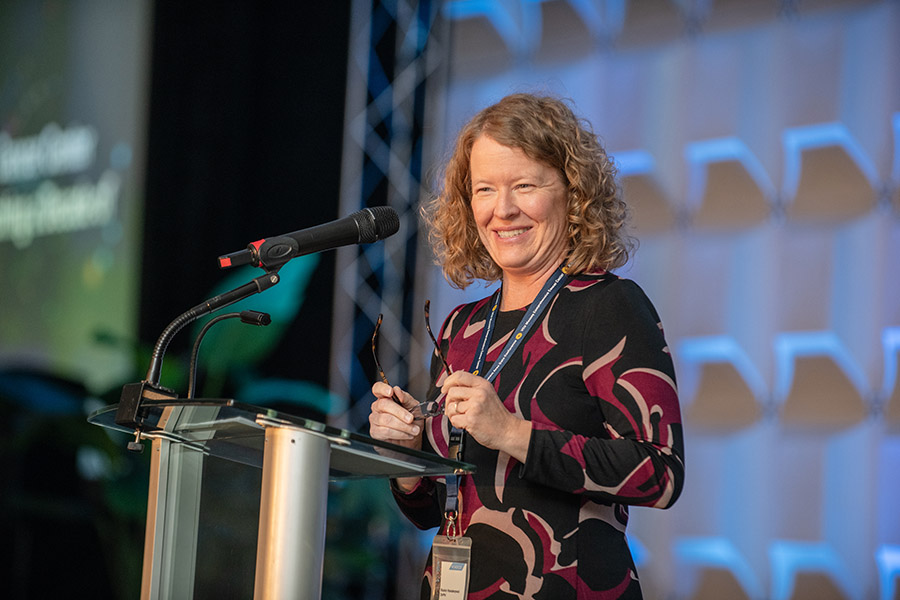 During a keynote address, Robin Vanderpool Dr.PH., of the National Cancer Institute, emphasized the idea that the country is at a critical inflection point to fully realize how NCI-designated cancer centers can use catchment area data to further their impact. (Terry Brown)
During a keynote address, Robin Vanderpool Dr.PH., of the National Cancer Institute, emphasized the idea that the country is at a critical inflection point to fully realize how NCI-designated cancer centers can use catchment area data to further their impact. (Terry Brown)
During brief remarks, Jennifer Pegher, M.A., executive director of the AACI, said that having this catchment area data readily available will help make community needs more accessible for cancer centers who are members of the AACI.
“I’m grateful to Dr. Winn and his amazing team for elevating this important discussion to a national level,” Pegher said.
Randall Oyer, M.D., FACC, medical director of the Ann B. Barshinger Cancer Institute at Penn Medicine Lancaster General Health, said that effectively and holistically addressing cancer prevention and care for all people in a center’s catchment area requires a deep knowledge of who lives in your community; who is represented and who is not represented.
“It requires a broad commitment to care for your entire community, not just the people that require your care,” Oyer said as he addressed the audience. “This takes willpower, courage and actionable data, which is what I’m intending to learn from all of you.”
During a plenary session on the evolving perspectives on cancer center catchment areas, Robert Hiatt, M.D., Ph.D., associate director of population sciences at UCSF Helen Diller Family Comprehensive Cancer Center, stated that cancer centers have made enormous progress in putting an emphasis on catchment areas, but there is still a need to go even further to impact patients and community members.
“I think we’ve become increasingly sophisticated about defining, describing and displaying catchment areas, but we need to go beyond definition,” Hiatt said.
In a panel discussion focused on navigating different catchment area data tools, Dinesh Mudaranthakam, Ph.D., M.B.A., director of research information technology at the University of Kansas Medical Center, underlined that centers need to identify the right tool that fits their catchment area needs, but communication and engagement with communities is just as imperative in effectively using those tools to properly address the cancer burdens within each center’s catchment area.
The second day of the conference was focused on conversations around the current state of catchment area data analytics as they pertain to cancer research.
Karen Knudsen, Ph.D., M.B.A., the CEO of the American Cancer Society and the ACS Cancer Action Network, delivered a keynote address on Friday, during which she said that something wonderful happens every day toward improving lives affected by cancer, but there still remains an unacceptably high cancer burden in the U.S.
She elaborated on ACS’ three-pronged strategy for impacting cancer incidence and outcomes in the country, which includes advocacy, discovery and patient support.
“Every decision we make has to be aligned with improving a life,” Knudsen said, adding that’s what ACS works to achieve every day and that mission is entirely driven by data.
Knudsen elaborated on how grant funding initiatives are aligned to the data problems that affect each state individually, highlighting that there are currently seven ACS grant-funded projects ongoing at Massey to address cancer issues specific to Virginia.
On Friday afternoon, another keynote presentation was given by Steve Kearney, Pharm.D., the global medical director at SAS, an AI, analytics and data management platform. He explained how statistical and data management software can serve as tools to help meet communities and individuals where they are to enhance public health and patient outcomes.
“Here’s the beautiful thing about this conference…Each of you in your day-to-day work does something that is so important that we have to empower you” to work faster, Kearney said.
Another plenary discussion explored how to leverage publicly available data for healthcare access, quality and equity. In this conversation, Lisa Richardson, M.D., M.P.H., director of the Division of Cancer Prevention and Control at the CDC, explained how the agency uses a national tracking network to identify public health patterns.
She also underlined what researchers and cancer scientists should never forget as more advanced data tools become available.
“We have to remember that people are not data points. The data represent the people,” Richardson said.
The third and final day of the conference looked toward the future of using cancer catchment area data to improve patient outcomes.
“The real performance begins now in the labs and communities, in the everyday conversations we have,” Winn said. “The patients, the people and the communities are waiting for us to bring the science to benefit not just some communities, but all communities.”
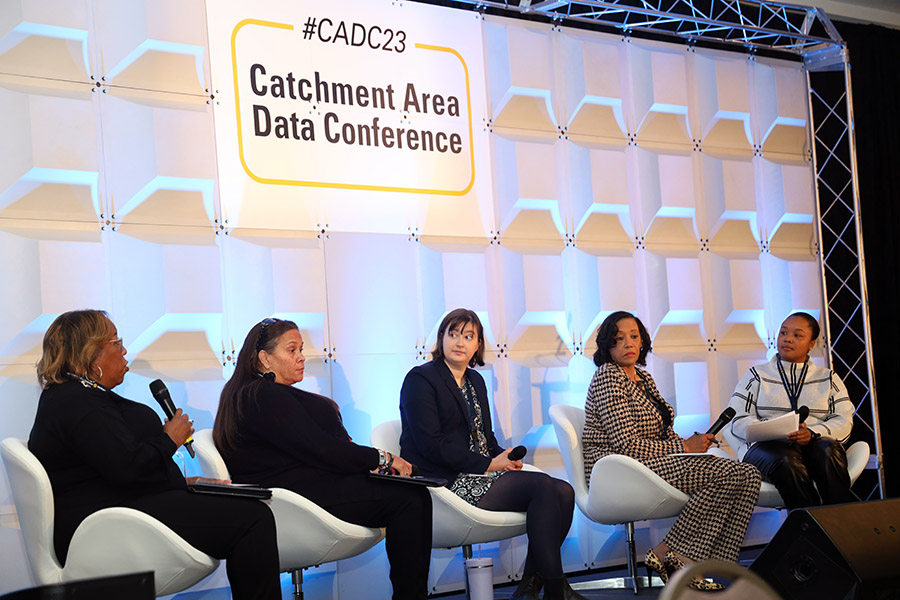 Rachel Hunley, M.A. (pictured far right), moderated a community panel discussion focused on supporting the community’s plan and power using cancer data insights, with featured panelists pictured from left to right: LaWanda Tatum, Susann Brown, Jennifer Shepheard, M.Sc., and Gaylene Kanoyton.
Rachel Hunley, M.A. (pictured far right), moderated a community panel discussion focused on supporting the community’s plan and power using cancer data insights, with featured panelists pictured from left to right: LaWanda Tatum, Susann Brown, Jennifer Shepheard, M.Sc., and Gaylene Kanoyton.
Rachel Hunley, M.A., the assistant director for catchment area data access and alignment at Massey, moderated a community panel discussion focused on supporting community partners to harness the power of cancer data insights, with featured panelists including Susann Brown, child care and program development director for the Chickahominy Tribe; Gaylene Kanoyton, Region 1 vice president for the Hampton City Branch of the NAACP; Jennifer Shepheard, M.Sc., population health epidemiologist with the Virginia Department of Health; and LaWanda Tatum, mayor of Lawrenceville, Virginia.
“When you actually go to the community and talk to the people, it has a major impact,” Kanoyton said.
“You can’t effectively treat a community if you don’t know them,” Brown added, saying that is how community trust in medicine and research is earned. “And that’s what Massey has done for us.”
Alex Krist, M.D., M.P.H., member of the Cancer Prevention and Control research program at Massey and a professor in the Department of Family Medicine at VCU, led a presentation on a comprehensive report that analyzed multiple models for understanding how to implement effective processes to change health care to better serve the communities within a health system’s particular catchment area.
“A whole health system needs to look different based on the community it serves,” Krist said.
In summary, Krist said that achieving whole health for all individuals needs to incorporate care that is: people-centered, comprehensive and holistic, upstream-focused, equitable and accountable, and simultaneously focused on clinical team members’ well-being.
In closing remarks, Tossas expressed optimism for the future of data in improving public health, but she also reiterated that researchers can never forget what the numbers are analyzing.
“Behind every data point is a human life. This reinforces our urgency that the patient is waiting,” Tossas said.
Other panel discussions throughout the three-day conference covered how to transform cancer care through public-private collaboration and technology innovation; using open-source software to enhance artificial intelligence, collaboration and interactivity in health care; and roundtable takeaways from the conference that could help chart the future of cancer center data analytics.
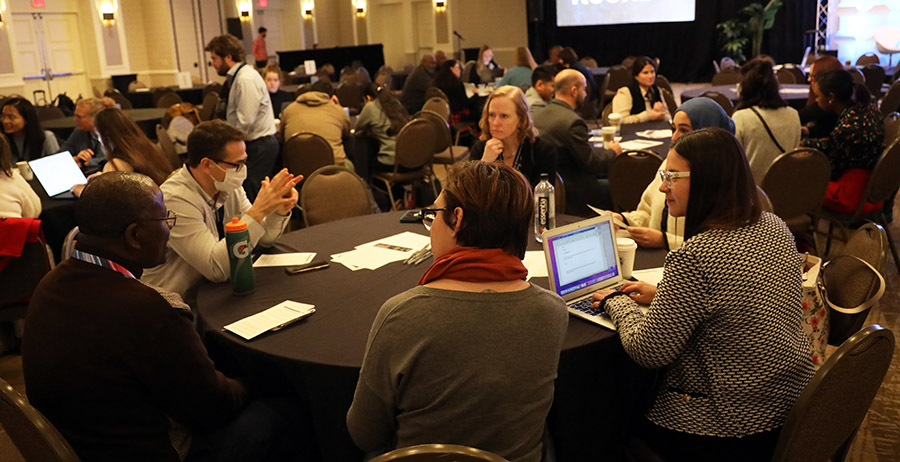 Attendees participated in roundtable discussions focused on key takeaways from the conference that could help chart the future of cancer center data analytics.
Attendees participated in roundtable discussions focused on key takeaways from the conference that could help chart the future of cancer center data analytics.
The CADC also included workshops that provided an overview of a number of data analytics tools, including Esri, Posit, SAS and Vibrent.
A poster session on Friday night showcased the latest advancements in cancer research, data analytics and their transformative impact on healthcare. Awards were given to three posters in the categories of Data Tools, Data Collection and Data Impact.
Presenting partners of this conference included the Association of American Cancer Institutes, SAS, University of Kentucky Markey Cancer Center and the Sidney Kimmel Cancer Research Consortium.
Written by: Blake Belden
Center News & Funding, Research, Prevention & Control, Clinical, Technology
Breast imaging expert explains how new FDA mammogram rules help patients make informed decisions about their careSep 27, 2024
Clinical, Research, Center News & Funding
Get C-SMART: Massey neuropsychologist seeks to enhance brain wellness in neuro-oncologySep 23, 2024
Center News & Funding, Community Engagement & Health Equity, Massey 50
Massey hosts congresswoman, highlights efforts to reduce cancer burden for all VirginiansSep 16, 2024
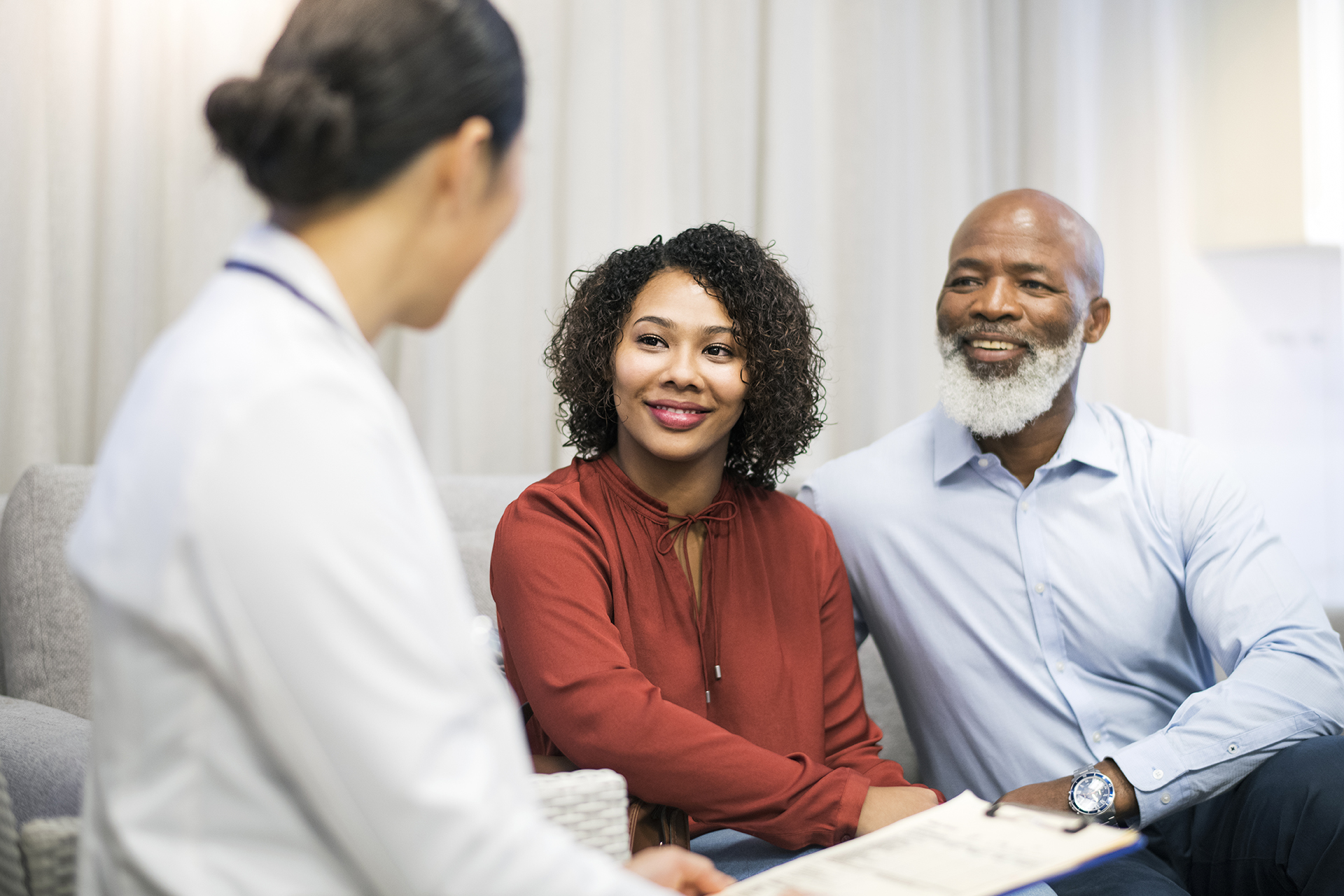
Treatments in clinical trials may be more effective or have fewer side effects than the treatments that are currently available. With more than 200 studies for multiple types of cancers and cancer prevention, Massey supports a wide array of clinical trials.
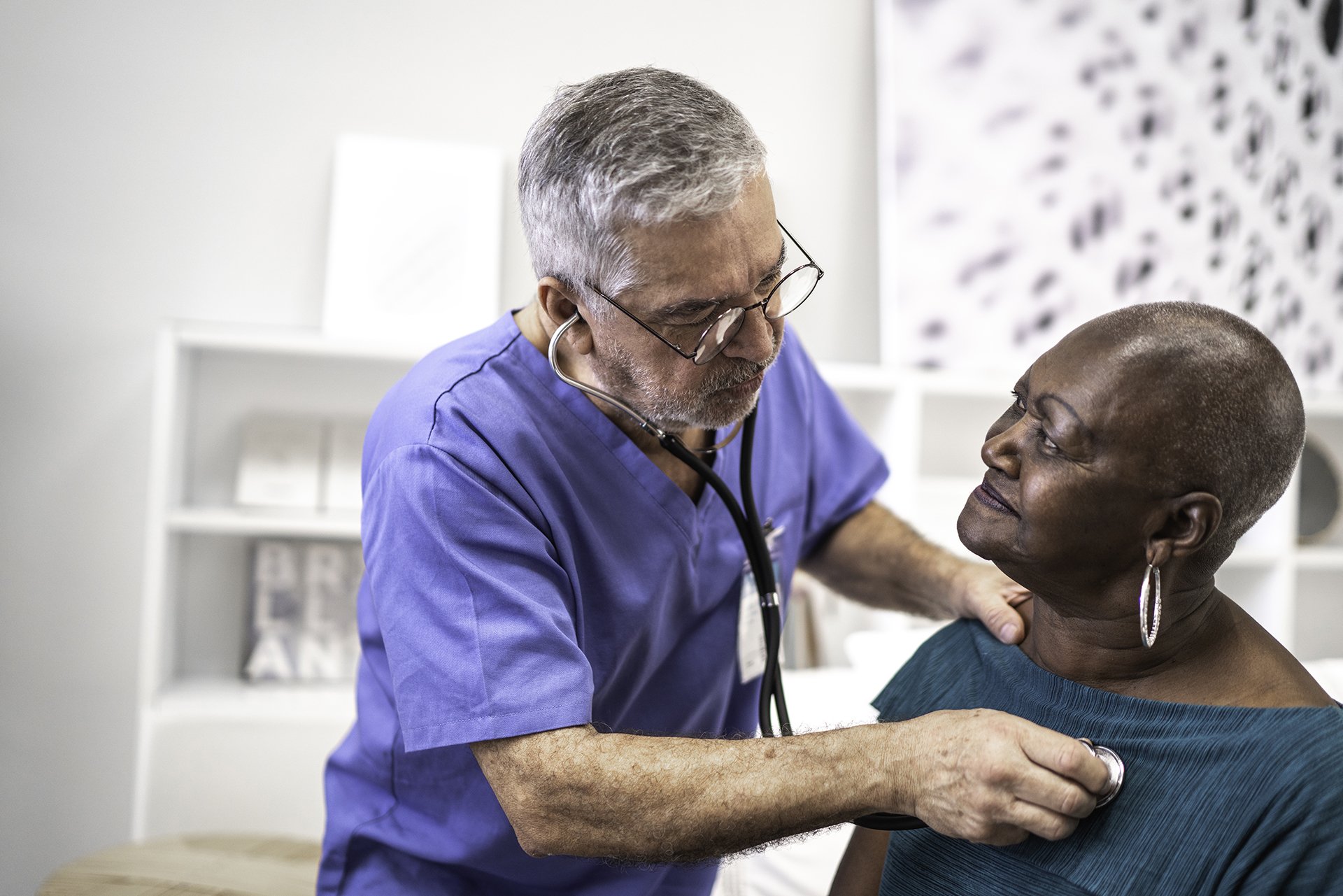
Massey supports hundreds of top cancer specialists serving the needs of our patients. Massey’s medical team provides a wealth of expertise in cancer diagnosis, treatment, prevention and symptom management.